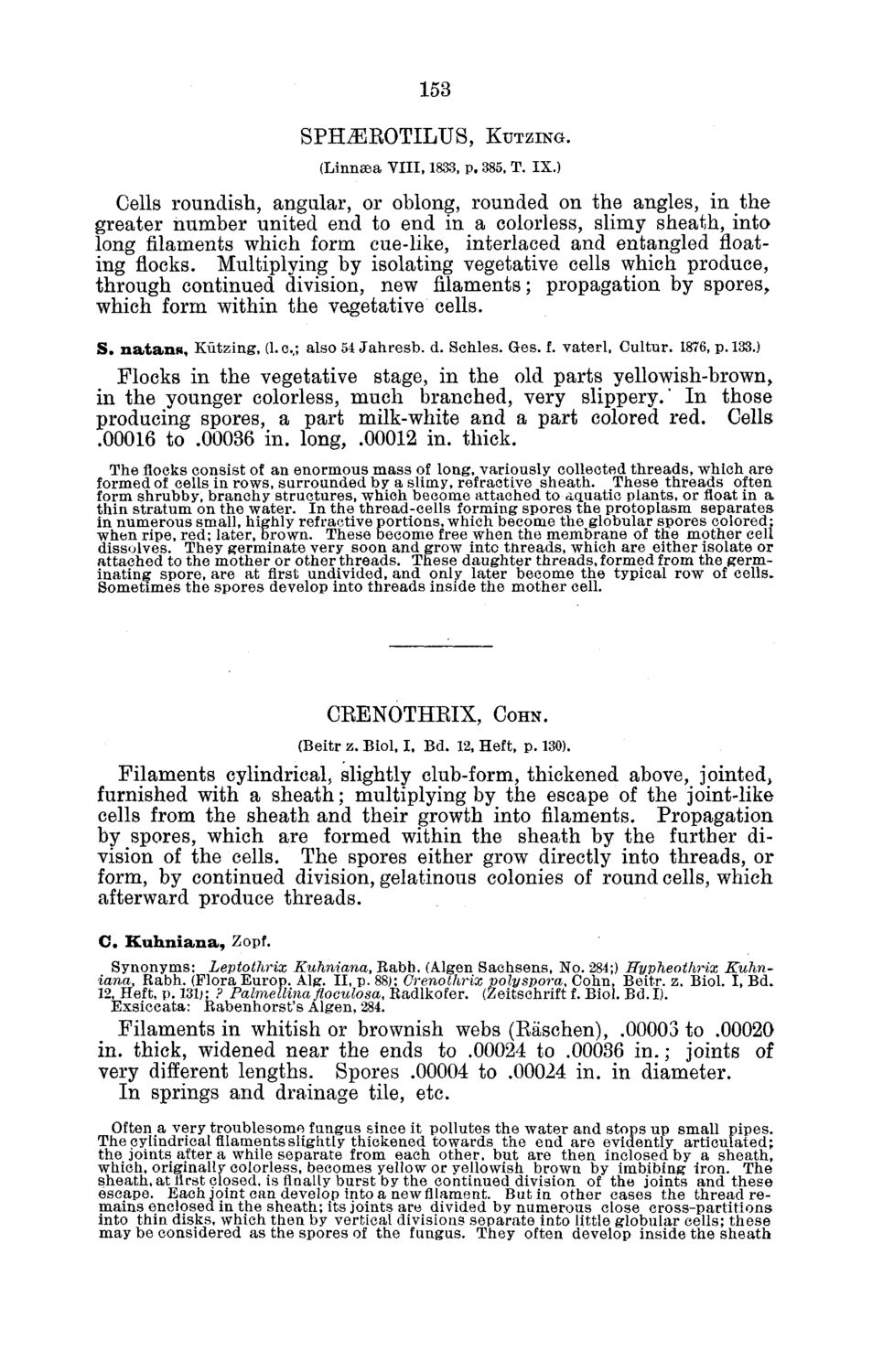| |
| |
Caption: Board of Trustees Minutes - 1882
This is a reduced-resolution page image for fast online browsing.

EXTRACTED TEXT FROM PAGE:
153 SPILEKOTILUS, KUTZING. (Linnaea VIII, 1833, p. 385, T. IX.) Cells roundish, angular, or oblong, rounded on the angles, in the greater number united end to end in a colorless, slimy sheath, into long filaments which form cue-like, interlaced and entangled floating flocks. Multiplying by isolating vegetative cells which produce, through continued division, new filaments; propagation by spores, which form within the vegetative cells. S. n a t a n s , Kutzing, (1. c.,; also 54 Jahresb. d. Schles. Ges. f. vaterl, Cultur. 1876, p. 133.) Flocks in the vegetative stage, in the old parts yellowish-brown, in the younger colorless, much branched, very slippery.' In those producing spores, a part milk-white and a part colored red. Cells .00016 to .00036 in. long, .00012 in. thick. The flocks consist of an enormous mass of long, variously collected threads, which are formed of cells in rows, surrounded by a slimy, refractive sheath. These threads often form shrubby, branchy structures, which become attached to aquatic plants, or float in a thin stratum on the water. In the thread-cells forming spores the protoplasm separates in numerous small, highly refractive portions, which become the globular spores colored: when ripe, red; later, brown. These become free when the membrane of the mother cell dissolves. They germinate very soon and grow into threads, which are either isolate or attached to the mother or other threads. These daughter threads, formed from the germinating spore, are at first undivided, and only later become the typical row of cells. Sometimes the spores develop into threads inside the mother cell. CEENOTHEIX, COHN. (Beitr z. Biol, I. Bd. 12, Heft, p. 130). Filaments cylindrical, slightly club-form, thickened above, jointed, furnished with a sheath; multiplying by the escape of the joint-like cells from the sheath and their growth into filaments. Propagation by spores, which are formed within the sheath by the further division of the cells. The spores either grow directly into threads, or form, by continued division, gelatinous colonies of round cells, which afterward produce threads. C. K u h n i a n a , Zopf. Synonyms: Leptothrix Kuhniana, Eabh. (Algen Sachsens, No. 284;) Hypheothrix Kuhniana, Rabh. (Flora Europ. Alg. II, p. 88); Grenothrix polyspora, Cohn, Beitr. z. Biol. I, Bd. 12, Heft, p. 131j; ? Palmellinafloculosa, Radlkof'er. (Zeitschrift f. Biol. Bd.I). Exsiccata: Rabenhorst's Algen, 284. Filaments in whitish or brownish webs (Easchen), .00003 to .00020 in. thick, widened near the ends to .00024 to .00036 in.; joints of very different lengths. Spores .00004 to .00024 in. in diameter. In springs and drainage tile, etc. Often a very troublesome fungus since it pollutes the water and stops up small pipes. The cylindrical filaments slightly thickened towards the end are evidently articulated; the joints after a while separate from each other, but are then inclosed by a sheath, which, originally colorless, becomes yellow or yellowish brown by imbibing iron. The sheath, at first closed, is finally burst by the continued division of the joints and these escape. Each joint can develop into a new filament. But in other cases the thread remains enclosed in the sheath; its joints are divided by numerous close cross-partitions into thin disks, which then by vertical divisions separate into little globular cells; these may be considered as the spores of the fungus. They often develop inside the sheath
| |